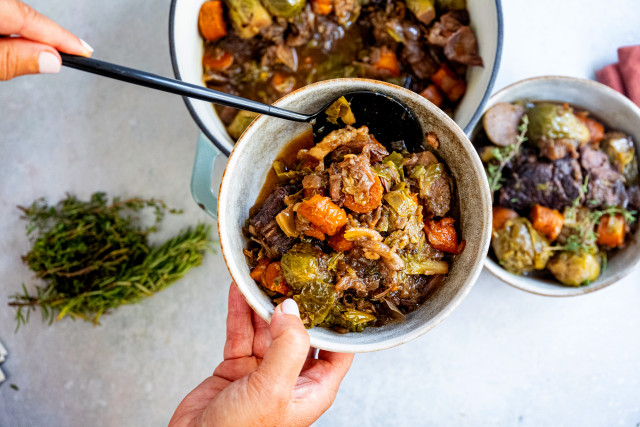
How to Reduce Period Pain Using Food as Medicine
Do you find yourself bloating, cramping, in pain and irritable every time that you get your period, wondering why you have to suffer through these symptoms every month? While PMS symptoms and period pain are extremely common, they really should not be your norm. Even though the conventional medicine system relies primarily on birth control to mask your pain and reduce symptoms, there are plenty of other effective lifestyle interventions that you can implement.
Having a lot of debilitating pain around the time of your cycle is typically a sign that something is out of whack: nutrient deficiencies, high levels of inflammation, gut imbalances, hormonal imbalances, and more. In this article, we are sharing steps that you can take to reduce these uncomfortable symptoms both during and outside of your menstrual phase, using food as medicine.
Nutrient to Add
Omega-3s
This healthy fat is known for its anti-inflammatory effects. Because it is so good at reducing inflammation, it has been shown to reduce period pain. In fact, one randomized controlled trial demonstrated that supplementing with omega-3s reduced period pain more than ibuprofen. To up your omega-3 intake, focus on adding more fatty fish that are low in mercury like wild salmon, mackerel or sardines. And increase your plant-based sources like chia seeds, flax seeds or walnuts. You may also need a fish oil supplement. This is where it's key to test your levels of omega 3s in your blood. We order this test on every client in our various programs because it's that important!
Vitamin D
Known as the sunshine vitamin, vitamin D is a crucial micronutrient that many are deficient in, due to lack of sun exposure. While deficiency can cause a host of issues, a recent study showed that those with blood levels below the recommended 30 ng/ml had a five times greater risk of developing menstrual cycle disorders than those with optimal levels. This result could be due to the fact that vitamin D deficiency may lead to lower levels of the hormone estradiol across the menstrual cycle. While more studies need to be done on the exact mechanism, there are a few ways that you can optimize your vitamin D levels in the meantime. Unfortunately, there are not many foods rich in vitamin D so the best way to increase vitamin D levels is to spend 15-30 minutes in the sun each day without sunscreen or take 1000-2000 IU of a quality, 3rd party tested vitamin D3 supplement. However, if you do choose to take a supplement, make sure to get your blood levels checked by your health practitioner.
Magnesium
Magnesium works wonders for period pain by reducing cramp severity. This is achieved by both relaxing uterine muscles and reducing the amount of circulating prostaglandins that can cause period pain. Magnesium is found in a host of whole foods including nuts and seeds, legumes, whole grains, and even chocolate, so now you have a great excuse to load up on 70% dark chocolate during your time of the month! Magnesium is another key nutrient that we test in all of our programs because deficiency is so common.
Turmeric
While this isn’t a nutrient, turmeric is known for its anti-inflammatory effects, working in a very similar way to NSAIDs such as Advil. A randomized controlled trial found that those who supplemented with curcumin—an active component of turmeric—for one week prior to and up to three days after their period saw significantly reduced PMS symptoms. To up your curcumin intake, try spicing up your meals with turmeric and black pepper (as black pepper helps you absorb the curcumin) or try supplements such as Theracumin. Please note, curcumin can have blood thinning effects, so check with your doctor before starting any supplements.
Ginger
Similarly to turmeric, ginger has been shown to have powerful anti-inflammatory effects. In fact, a recent randomized controlled trial showed that ginger reduced both the pain intensity and duration of menstrual cramps. Next time your period rolls around, try sprinkling dried ginger on your meals to add a kick of heat, grate fresh ginger into your smoothies, or sip on ginger tea throughout the day. Here is a recipe for our favorite Anti-Inflammatory Cinnamon Lemon Ginger Tea.
Thiamin
Also known as vitamin B1, this can help with period pain since it serves as a coenzyme for many functions in the body including those related to mentation, carbohydrate metabolism, and the neuromuscular system. Because of its function, thiamin has been shown to reduce both the mental and physical effects of PMS, causing less depressive symptoms and less muscular contraction of the uterus, leading to reduced cramping. Thiamin is abundant in whole foods such as quality meats, seafood, and fish, green vegetables, legumes, and whole grains, so be sure to load up on these whole foods before and during your menstrual phase. This is another key nutrient that we test in our programs to ensure that you have adequate levels!
Fiber
Fiber is known for improving bowel regularity, lowering cholesterol, and increasing satiety, but did you also know that fiber can reduce menstrual pain? This is because fiber can prevent you from reabsorbing estrogen by helping you excrete it in your stool. This function prevents you from retaining to much estrogen which can lead to increased period pain. In fact, women in Japan who ate more whole food fiber such as legumes, vegetables, and whole grains were found to have less menstrual cramps due to decreased estrogen levels. Up your fiber intake by choosing whole foods such as vegetables, fruit, legumes, nuts, and seeds to decrease estrogen reabsorption.
Compounds to Limit
Added Sugars
Conversely to how omega-3s and curcumin are anti-inflammatory and thus reduce period pain, added sugars can increase inflammation in the body, leading to increased period pain. In fact, those with worse PMS were observed to have higher levels of CRP, a potent marker of inflammation. While it may feel impossible to avoid added sugars during your menstrual period as cravings run rampant, you can reduce these cravings by balancing your meals with the Optimal Plate Method, opting for protein, fats, and fiber-filled carbohydrates and making sure that you are eating enough whole foods to fuel your body. Let us help you use food as medicine consistently every day with blood sugar balancing meal plans! Our team of functional medicine dietitians would love to support you in The Being Collective, our meal planning and coaching program that includes hundreds of blood sugar balancing recipes, a weekly plan that you create for you and/or your family that generates an automated grocery list and a meal prep plan for the week. This is the best way to improve your efficiency in the kitchen, get DELICIOUS blood sugar balancing meals on your plate, and help you make progress with your health goals.
Caffeine
While you may turn to that extra cup of coffee to get you through the fatigue that accompanies your monthly period, caffeine can actually make you feel worse. While the evidence on caffeine and PMS is mixed, too much caffeine can dehydrate you, causing you to actually hold on to more water which will worsen the typical bloating that accompanies your period. It can also serve as a vasoconstrictor, causing the blood vessels that enter your uterus to tighten, making period cramps even worse. The American College of Obstetrics and Gynecology recommends limiting caffeine to reduce PMS symptoms, so try to limit your daily caffeine intake to just one cup of coffee or tea.
Alcohol
Like caffeine, alcohol can also cause dehydration which worsens period cramps and bloating. It can also increase estrogen and testosterone production when consumed in higher amounts, increasing the amount of circulating prostaglandins in your body which will worsen your PMS symptoms. Furthermore, drinkers have 45% higher rates of PMS than their non-drinking counterparts while heavy drinkers have 79% higher rates of PMS than those non-drinkers. While it may be tempting to turn to a bottle of wine when PMS strikes, stick to a maximum of one glass per day and make sure to drink plenty of water with your alcohol.
Pesticide Exposure
You may not think pesticides have anything to do with your period cramps, but think again. Pesticides can act as xenoestrogens, meaning that they mimic your body’s natural hormones. This mimicry can lead to increased levels of estrogen in your body, causing increased period pain and may potentially be linked to other gynecological disorders such as endometriosis or PCOS. To avoid excess pesticide exposure, purchase organic produce and grains when possible, especially when dealing with the dirty dozen, and wash your produce well if you are unable to purchase organic.
Plastic in Food
Like pesticides, plastic can also serve as a xenoestrogen, increasing the amount of circulating estrogen in your body. In fact, those that had higher levels of BPA (a chemical in plastic) in their urine had significantly worse periods than those with lower levels. To avoid these chemicals, choose glass or stainless steel Tupperware and food storage products over plastic and choose canned foods that are BPA free.
Overall, there are many things you can do to make your period and the time before it much more enjoyable/functional. Next time you find yourself agonizing through PMS or period cramps refer to the above tips to improve your cycle. And if you have tried these strategies but are still struggling, join us in My Food is Health or our VIP Next Level Nutrition Program to go deeper on creating healthy hormones.


